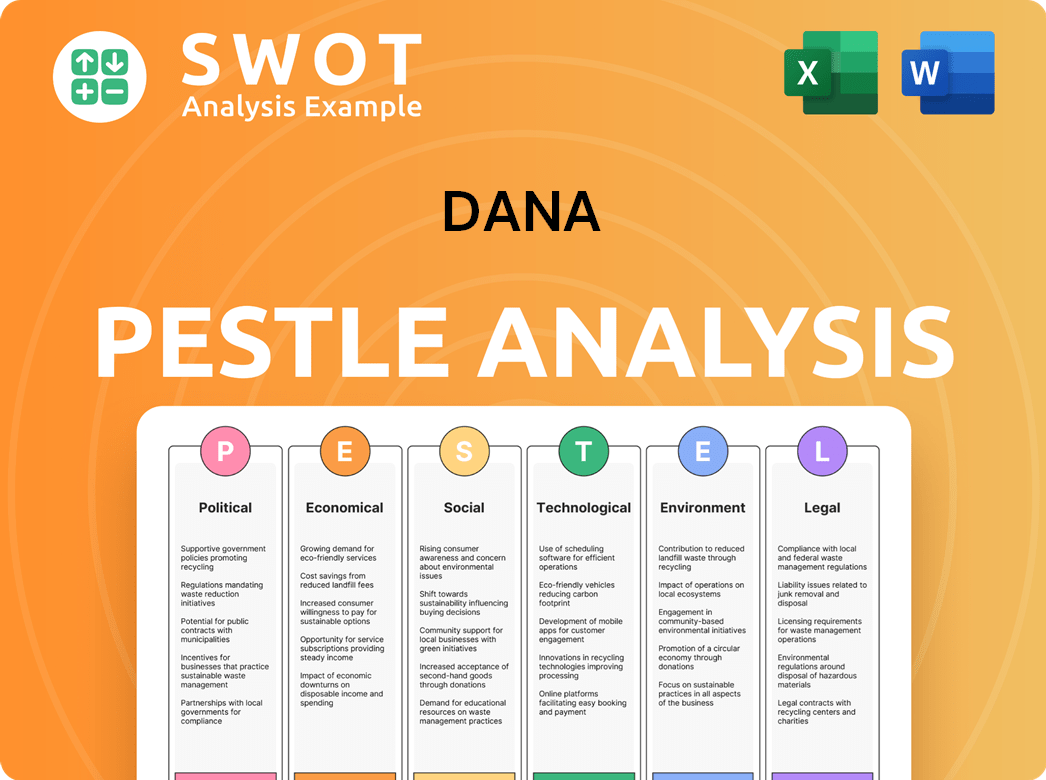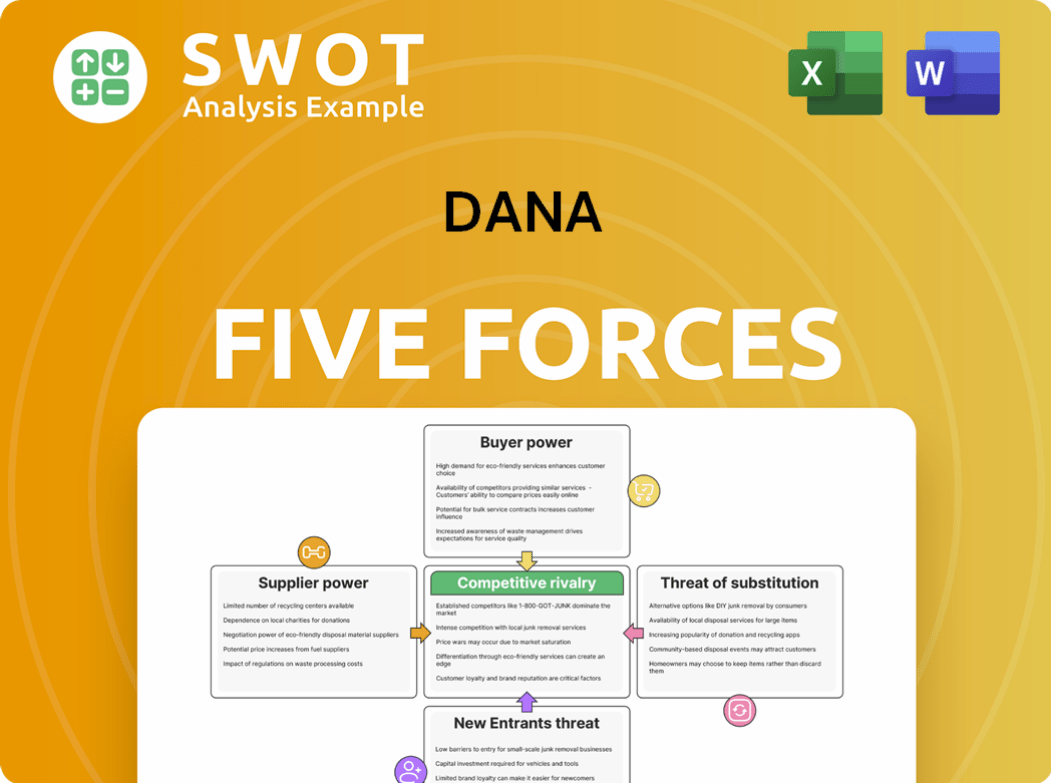Dana Bundle
Who Really Owns Dana Incorporated?
Ownership is the bedrock of any company, dictating its destiny and influencing every strategic move. With the proposed sale of its Off-Highway business in June 2025, the spotlight is firmly on Dana Incorporated. Understanding the Dana SWOT Analysis is crucial to understand the company's position.

Founded in 1904, Dana Company, originally Spicer Universal Joint Manufacturing Company, has evolved into a global powerhouse. This exploration into Dana Company ownership will uncover the key players, from the founder to the current Dana Incorporated owner, and how their influence shapes the company's future. This deep dive into Dana's history, its financial reports, and the role of Dana Incorporated shareholders is essential for anyone seeking to understand the dynamics of this industry leader. We'll examine the company's market capitalization and its position relative to its competitors, answering questions like "Who is the CEO of Dana Company?" and "Is Dana a public company?"
Who Founded Dana?
The story of Dana Incorporated, or Dana Company, begins in 1904 with Clarence W. Spicer, an engineer who invented universal joints. Spicer's initial focus was on manufacturing these joints, which were first shipped to the Corbin Motor Company. The company's journey from a small manufacturing startup to a global supplier of automotive components is a testament to its early strategic decisions and leadership.
In 1905, the Spicer Universal Joint Manufacturing Company was officially established with an authorized capital of $35,000, divided into 700 shares. Within its first year, the company achieved sales of nearly $40,000, which more than doubled to $83,000 the following year, demonstrating strong initial growth and market acceptance of its products. The evolution of Dana's ownership structure reflects its strategic adaptations and expansion over the years.
Charles A. Dana's entrance in 1914 marked a turning point, as he later became president. The company's renaming to Dana Corporation in 1946 honored his significant contributions. While the precise ownership details of the early investors are not available, Charles Dana's leadership and the company's subsequent renaming suggest his considerable influence and ownership stake. This highlights the pivotal role of key individuals in shaping the company's trajectory.
Clarence W. Spicer founded the company in 1904, initially manufacturing universal joints.
The company was formally incorporated in 1905 with an authorized capital of $35,000.
In 1909, the company's name changed to Spicer Manufacturing Company.
Charles A. Dana joined in 1914 and later became president, significantly shaping the company.
In 1946, the company was renamed Dana Corporation in honor of Charles Dana.
Initial sales were nearly $40,000 in the first year, doubling to $83,000 the following year.
Early strategic decisions, such as acquiring a stake in its English licensee, Hardy Spicer, in 1925, show Dana's vision for growth and control. As of the latest financial reports, the company's market capitalization is approximately $1.8 billion. Understanding the history of Dana Company ownership provides insights into its evolution and strategic direction. For more detailed information, you can refer to resources that offer a comprehensive overview of the company's financial performance and ownership structure, such as articles that delve into the topic of Dana Company ownership.
The early years of Dana Incorporated were marked by innovative engineering and strategic growth.
- Clarence W. Spicer founded the company in 1904.
- Charles A. Dana played a crucial role, becoming president and influencing the company's direction.
- The company's early sales growth and strategic acquisitions demonstrate its ambition.
- Dana's market capitalization is currently around $1.8 billion.
- The evolution of Dana Company ownership reflects its adaptation and expansion.
Dana SWOT Analysis
- Complete SWOT Breakdown
- Fully Customizable
- Editable in Excel & Word
- Professional Formatting
- Investor-Ready Format

How Has Dana’s Ownership Changed Over Time?
As a publicly traded entity, the ownership of Dana Incorporated is spread across a diverse group of shareholders. These include institutional investors, individual investors, and company insiders. The company's history includes being listed on the New York Stock Exchange since 1922. As of February 25, 2025, there were 145,724,477 shares of Dana's common stock available for voting.
The ownership structure of Dana has been influenced by significant events over time. One such event was the bankruptcy filing in 2006, which led to the cancellation of 150 million shares of the old stock in 2007. More recently, Dana has been actively managing its portfolio strategically. For example, on June 11, 2025, Dana announced an agreement to sell its Off-Highway business to Allison Transmission Holdings, Inc. for $2.7 billion. This strategic move, expected to finalize in late Q4 2025, is aimed at generating value for shareholders and strengthening Dana's financial position through substantial debt reduction, with plans to repay roughly $2 billion of debt. These changes reflect a strategic shift towards streamlining the business and focusing on light vehicle and commercial vehicle systems, impacting the company's strategy and governance by concentrating its portfolio.
| Shareholder | Shares Held | Percentage of Ownership |
|---|---|---|
| Vanguard Fiduciary Trust Co. | 16,624,715 | 11.46% |
| Carl Celian Icahn (Investment Company) | 14,286,505 | 9.85% |
| Total Institutional Holdings (Reported by 624 owners) | 187,134,240 | Significant Portion |
Major institutional shareholders include BlackRock, Inc., Vanguard Group Inc, and others. Vanguard Fiduciary Trust Co. holds 11.46% with 16,624,715 shares, while Carl Celian Icahn (Investment Company) holds 9.85% with 14,286,505 shares. These institutional holdings represent a substantial portion of the company's ownership. For a deeper understanding of the competitive environment, consider exploring the Competitors Landscape of Dana.
Dana Company ownership is distributed among various shareholders, with institutional investors holding a significant portion.
- Institutional investors play a key role in Dana's ownership structure.
- Strategic decisions, such as the sale of the Off-Highway business, impact the company's direction.
- Understanding the shareholder composition is crucial for assessing the company's financial health and future prospects.
- Key events like the 2006 bankruptcy have reshaped the ownership landscape.
Dana PESTLE Analysis
- Covers All 6 PESTLE Categories
- No Research Needed – Save Hours of Work
- Built by Experts, Trusted by Consultants
- Instant Download, Ready to Use
- 100% Editable, Fully Customizable

Who Sits on Dana’s Board?
The Board of Directors at Dana Incorporated oversees the company's strategic direction and governance. As of March 14, 2025, the Board was preparing for the Annual Meeting of Shareholders, scheduled virtually for April 24, 2025. Shareholders of record as of February 25, 2025, were eligible to vote. On that date, there were 145,724,477 shares of common stock outstanding and eligible to be voted.
The structure of the board includes various members, some of whom may represent significant shareholders or hold independent positions. R. Bruce McDonald, a director since 2014, served as interim Chairman of the Board, President, and Chief Executive Officer as of November 2024. Michael J. Mack, Jr. chairs the Audit Committee, with Brett M. Icahn and Diarmuid B. O'Connell also on the committee as of February 11, 2025. Understanding the composition of the board is crucial for anyone interested in the Growth Strategy of Dana.
| Director | Position | Since |
|---|---|---|
| R. Bruce McDonald | Interim Chairman of the Board, President, and CEO | 2014 |
| Michael J. Mack, Jr. | Chairperson of the Audit Committee | N/A |
| Brett M. Icahn | Member of the Audit Committee | N/A |
| Diarmuid B. O'Connell | Member of the Audit Committee | N/A |
At the annual meeting, shareholders voted on key proposals, including the election of directors, an advisory vote on executive compensation, and the ratification of the independent registered public accounting firm. A shareholder proposal for an independent Board Chairman was not approved at the April 24, 2025, annual general meeting. Each outstanding share of common stock is entitled to one vote, reflecting a one-share-one-vote structure. The company's executive officers are also subject to stock ownership guidelines, requiring them to own a significant number of shares based on a multiple of their annual base salary.
The Board of Directors manages Dana Incorporated, with shareholders voting on key decisions. The board includes members with diverse roles and responsibilities. Shareholders have a one-vote-per-share structure.
- Shareholders vote on director elections and executive compensation.
- Executive officers must meet stock ownership guidelines.
- The Annual Meeting of Shareholders was held virtually on April 24, 2025.
- Understanding the board's composition is key to understanding Dana's governance.
Dana Business Model Canvas
- Complete 9-Block Business Model Canvas
- Effortlessly Communicate Your Business Strategy
- Investor-Ready BMC Format
- 100% Editable and Customizable
- Clear and Structured Layout

What Recent Changes Have Shaped Dana’s Ownership Landscape?
Over the past few years, significant changes have reshaped the ownership and strategic direction of Dana Incorporated. A pivotal move was the June 11, 2025, announcement of an agreement to sell its Off-Highway business to Allison Transmission Holdings, Inc. for $2.7 billion. This strategic divestiture aims to streamline Dana's operations, focusing on its core light vehicle and commercial vehicle segments. The transaction is expected to yield approximately $2.4 billion in net cash after taxes and expenses, with plans to allocate around $2 billion towards debt repayment and return about $550 million to shareholders upon or before closing.
Leadership transitions also played a role in the company's recent developments. In November 2024, R. Bruce McDonald assumed the roles of Chairman and CEO, succeeding James Kamsickas. This change coincided with the Off-Highway business sale announcement and the initiation of a $200 million cost reduction plan, later increased to a target of $300 million through 2026. These cost-saving measures are designed to enhance value creation and improve operational efficiency. These changes are directly related to the question of Who owns Dana and how the company is positioning itself for the future. If you are interested in how to invest in Dana stock, you could check the Marketing Strategy of Dana.
| Metric | 2024 (Preliminary) | 2025 (Projected) |
|---|---|---|
| Sales | $10.3 billion | $9.525 billion - $10.025 billion |
| Adjusted EBITDA | $885 million | $925 million - $1.025 billion |
Financially, Dana demonstrated resilience in 2024, with preliminary sales reaching $10.3 billion and an adjusted EBITDA of $885 million, marking a 60-basis-point margin improvement compared to 2023. For 2025, the company projects sales between $9.525 billion and $10.025 billion, with an adjusted EBITDA ranging from $925 million to $1.025 billion. The company’s commitment to shareholders is evident through a declared quarterly dividend of $0.10 per share, payable on May 31, 2025, to shareholders of record as of May 10, 2025. These actions highlight Dana's strategic shift toward a more focused business model and a commitment to improving its financial health, reflecting broader trends in the industry.
The ownership structure of Dana has evolved, with strategic decisions like the Off-Highway business sale impacting its future. The primary focus is now on light and commercial vehicle segments.
Shareholders and institutional investors are key owners. The company's focus on returning capital to shareholders reflects their influence and the company's financial strategy.
Institutional investors and public shareholders are the main owners. The leadership transition and strategic shifts influence the company's direction.
Dana's business is undergoing transformation, with a focus on streamlining operations and enhancing financial performance, as seen in its 2024 and 2025 projections.
Dana Porter's Five Forces Analysis
- Covers All 5 Competitive Forces in Detail
- Structured for Consultants, Students, and Founders
- 100% Editable in Microsoft Word & Excel
- Instant Digital Download – Use Immediately
- Compatible with Mac & PC – Fully Unlocked

Related Blogs
- What are Mission Vision & Core Values of Dana Company?
- What is Competitive Landscape of Dana Company?
- What is Growth Strategy and Future Prospects of Dana Company?
- How Does Dana Company Work?
- What is Sales and Marketing Strategy of Dana Company?
- What is Brief History of Dana Company?
- What is Customer Demographics and Target Market of Dana Company?
Disclaimer
All information, articles, and product details provided on this website are for general informational and educational purposes only. We do not claim any ownership over, nor do we intend to infringe upon, any trademarks, copyrights, logos, brand names, or other intellectual property mentioned or depicted on this site. Such intellectual property remains the property of its respective owners, and any references here are made solely for identification or informational purposes, without implying any affiliation, endorsement, or partnership.
We make no representations or warranties, express or implied, regarding the accuracy, completeness, or suitability of any content or products presented. Nothing on this website should be construed as legal, tax, investment, financial, medical, or other professional advice. In addition, no part of this site—including articles or product references—constitutes a solicitation, recommendation, endorsement, advertisement, or offer to buy or sell any securities, franchises, or other financial instruments, particularly in jurisdictions where such activity would be unlawful.
All content is of a general nature and may not address the specific circumstances of any individual or entity. It is not a substitute for professional advice or services. Any actions you take based on the information provided here are strictly at your own risk. You accept full responsibility for any decisions or outcomes arising from your use of this website and agree to release us from any liability in connection with your use of, or reliance upon, the content or products found herein.